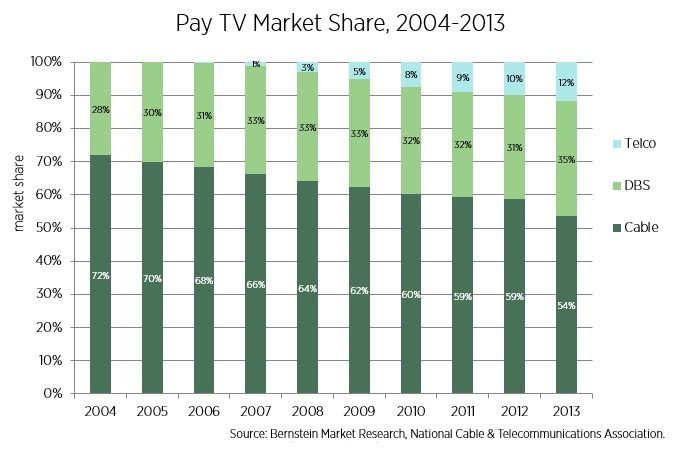Congress is considering reforming television laws and solicited comment from the public last month. On Friday, I submitted a letter encouraging the reform effort. I attached the paper Adam and I wrote last year about the current state of video regulations and the need for eliminating the complex rules for television providers.
As I say in the letter, excerpted below, pay TV (cable, satellite, and telco-provided) is quite competitive, as this chart of pay TV market share illustrates. In addition to pay TV there is broadcast, Netflix, Sling, and other providers. Consumers have many choices and the old industrial policy for mass media encourages rent-seeking and prevents markets from evolving.
Dear Chairman Upton and Chairman Walden:
Thank you for the opportunity to respond to the Committee’s December 2014 questions on video regulation.
…The labyrinthine communications and copyright laws governing video distribution are now distorting the market and therefore should be made rational. Congress should avoid favoring some distributors at the expense of free competition. Instead, policy should encourage new entrants and consumer choice.
The focus of the committee’s white paper on how to “foster” various television distributors, while understandable, was nonetheless misguided. Such an inquiry will likely lead to harmful rules that favor some companies and programmers over others, based on political whims. Congress and the FCC should get out of “fostering” the video distribution markets completely. A light-touch regulatory approach will prevent the damaging effects of lobbying for privilege and will ensure the primacy of consumer choice.
Some of the white paper’s questions may actually lead policy astray. Question 4, for instance, asks how we should “balance consumer welfare and the rights of content creators” in video markets. Congress should not pursue this line of inquiry too far. Just consider an analogous question: how do we balance consumer welfare and the interests of content creators in literature and written content? The answer is plain: we don’t. It’s bizarre to even contemplate.
Congress does not currently regulate the distribution markets of literature and written news and entertainment. Congress simply gives content producers copyright protection, which is generally applicable. The content gets aggregated and distributed on various platforms through private ordering via contract. Congress does not, as in video, attempt to keep competitive parity between competing distributors of written material: the Internet, paperback publishers, magazine publishers, books on tape, newsstands, and the like. Likewise, Congress should forego any attempt at “balancing” in video content markets. Instead, eliminate top-down communications laws in favor of generally applicable copyright laws, antitrust laws, and consumer protection laws.
As our paper shows, the video distribution marketplace has changed drastically. From the 1950s to the 1990s, cable was essentially consumers’ only option for pay TV. Those days are long gone, and consumers now have several television distributors and substitutes to choose from. From close to 100 percent market share of the pay TV market in the early 1990s, cable now has about 50 percent of the market. Consumers can choose popular alternatives like satellite- and telco-provided television as well as smaller players like wireless carriers, online video distributors (such as Netflix and Sling), wireless Internet service providers (WISPs), and multichannel video and data distribution service (MVDDS or “wireless cable”). As many consumers find Internet over-the-top television adequate, and pay TV an unnecessary expense, “free” broadcast television is also finding new life as a distributor.
The New York Times reported this month that “[t]elevision executives said they could not remember a time when the competition for breakthrough concepts and creative talent was fiercer” (“Aiming to Break Out in a Crowded TV Landscape,” January 11, 2015). As media critics will attest, we are living in the golden age of television. Content is abundant and Congress should quietly exit the “fostering competition” game. Whether this competition in television markets came about because of FCC policy or in spite of it (likely both), the future of television looks bright, and the old classifications no longer apply. In fact, the old “silo” classifications stand in the way of new business models and consumer choice.
Therefore, Congress should (1) merge the FCC’s responsibilities with the Federal Trade Commission or (2) abolish the FCC’s authority over video markets entirely and rely on antitrust agencies and consumer protection laws in television markets. New Zealand, the Netherlands, Denmark, and other countries have merged competition and telecommunications regulators. Agency merger streamlines competition analyses and prevents duplicative oversight.
Finally, instead of fostering favored distribution channels, Congress’ efforts are better spent on reforms that make it easier for new entrants to build distribution infrastructure. Such reforms increase jobs, increase competition, expand consumer choice, and lower consumer prices.
Thank you for initiating the discussion about updating the Communications Act. Reform can give America’s innovative telecommunications and mass-media sectors a predictable and technology neutral legal framework. When Congress replaces industrial planning in video with market forces, consumers will be the primary beneficiaries.
Sincerely,
Brent Skorup
Research Fellow, Technology Policy Program
Mercatus Center at George Mason University


 The Technology Liberation Front is the tech policy blog dedicated to keeping politicians' hands off the 'net and everything else related to technology.
The Technology Liberation Front is the tech policy blog dedicated to keeping politicians' hands off the 'net and everything else related to technology.